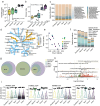Segmental patterning of microbiota and immune cells in the murine intestinal tract
- PMID: 39254265
- PMCID: PMC11404582
- DOI: 10.1080/19490976.2024.2398126
Segmental patterning of microbiota and immune cells in the murine intestinal tract
Abstract
The intestine exhibits distinct characteristics along its length, with a substantial immune cell reservoir and diverse microbiota crucial for maintaining health. This study investigates how anatomical location and regional microbiota influence intestinal immune cell abundance. Using conventionally colonized and germ-free mice, segment-specific immune cell composition and microbial communities were assessed. Metagenomic sequencing analyzed microbiome variations, while flow cytometry and immunofluorescence examined immune cell composition. Microbiome composition varied significantly along the intestine, with diversity and abundance increasing from upper to lower segments. Immune cells showed distinct segment-specific patterning influenced by microbial colonization and localization. T cell subsets displayed varied dependence on microbiome presence and anatomical location. This study highlights locoregional differences in intestinal immune cell and microbiome composition, identifying immune subsets susceptible to microbiota presence. The findings provide context for understanding immune cell alterations in disease models.
Keywords: Microbiome; germ-free vs colonized; immune cells; segmental patterning.
Conflict of interest statement
No potential conflict of interest was reported by the author(s).
Figures






Similar articles
-
Life-long microbiome rejuvenation improves intestinal barrier function and inflammaging in mice.Microbiome. 2025 Apr 2;13(1):91. doi: 10.1186/s40168-025-02089-8. Microbiome. 2025. PMID: 40176137 Free PMC article.
-
Interleukin-15 promotes intestinal dysbiosis with butyrate deficiency associated with increased susceptibility to colitis.ISME J. 2017 Jan;11(1):15-30. doi: 10.1038/ismej.2016.114. Epub 2016 Sep 20. ISME J. 2017. PMID: 27648810 Free PMC article.
-
Fecal microbiota transplantation from protozoa-exposed donors downregulates immune response in a germ-free mouse model, its role in immune response and physiology of the intestine.PLoS One. 2024 Oct 28;19(10):e0312775. doi: 10.1371/journal.pone.0312775. eCollection 2024. PLoS One. 2024. PMID: 39466773 Free PMC article.
-
Regional specialization within the intestinal immune system.Nat Rev Immunol. 2014 Oct;14(10):667-85. doi: 10.1038/nri3738. Epub 2014 Sep 19. Nat Rev Immunol. 2014. PMID: 25234148 Review.
-
Strategies to Dissect Host-Microbial Immune Interactions That Determine Mucosal Homeostasis vs. Intestinal Inflammation in Gnotobiotic Mice.Front Immunol. 2020 Feb 18;11:214. doi: 10.3389/fimmu.2020.00214. eCollection 2020. Front Immunol. 2020. PMID: 32133003 Free PMC article. Review.
Cited by
-
Recent insights and advances in gut microbiota's influence on host antiviral immunity.Front Microbiol. 2025 Feb 27;16:1536778. doi: 10.3389/fmicb.2025.1536778. eCollection 2025. Front Microbiol. 2025. PMID: 40083779 Free PMC article. Review.
-
Study on intestinal microbial communities of three different cattle populations on Qinghai-Tibet Plateau.PLoS One. 2025 Feb 4;20(2):e0312314. doi: 10.1371/journal.pone.0312314. eCollection 2025. PLoS One. 2025. PMID: 39903702 Free PMC article.
References
MeSH terms
LinkOut - more resources
Full Text Sources
